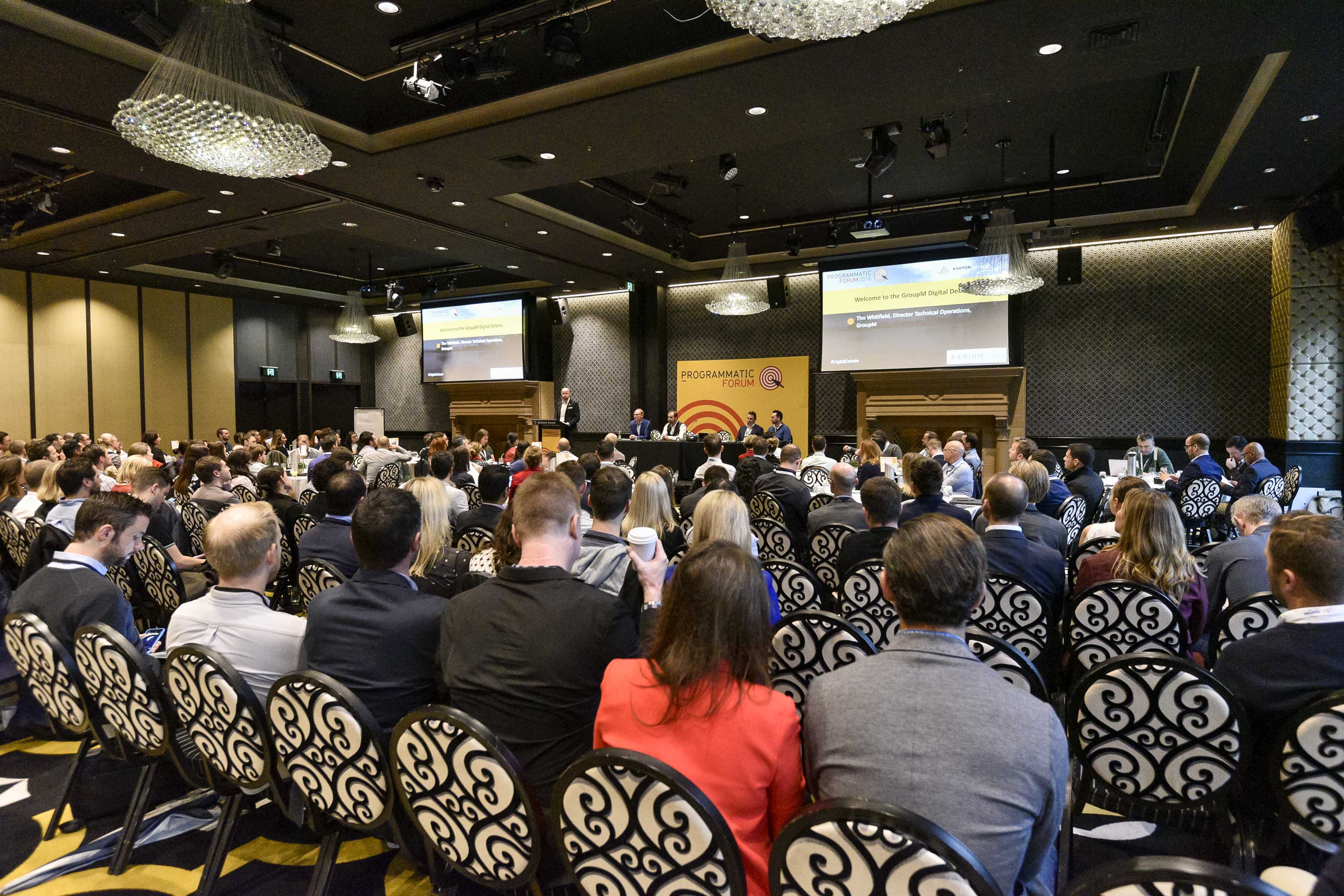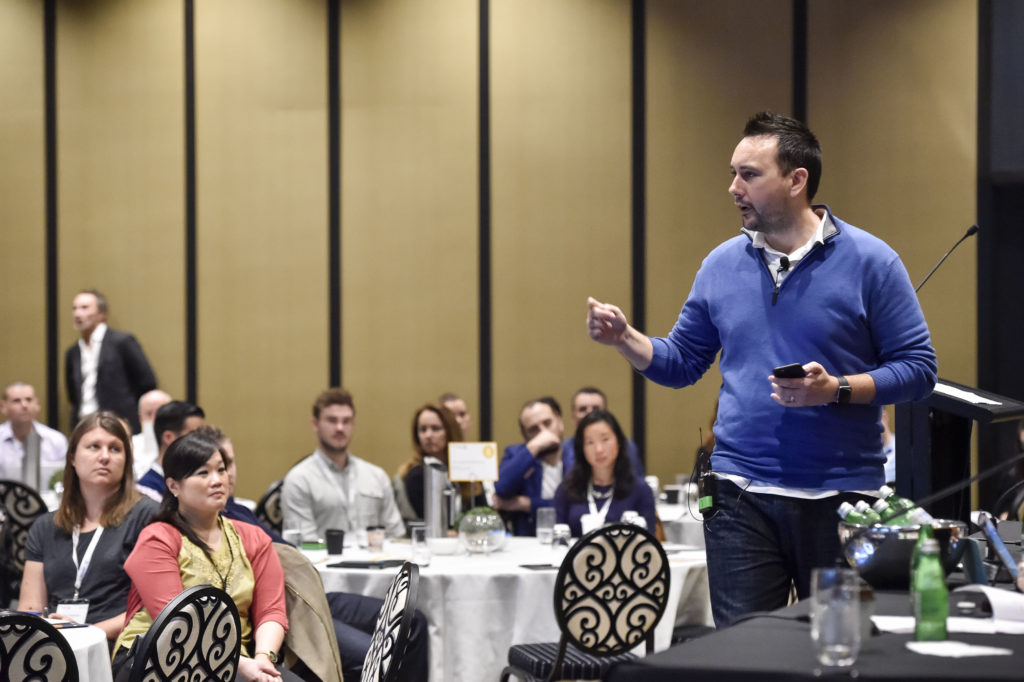
READING TIME: 10 minutes
With a resounding 70% of attendees at the Programmatic Forum voting in its favour, full stack technology is the clear winner of the first GroupM digital debate. Held in Sydney, the debate saw two teams go head to head to decide whether full stack or pure play technology is the better way for brands to go.
Moderated by Tim Whitfield, director of technical operations for GroupM, arguing for pure play Sam Smith, Managing Director, TubeMogul and Peter Hunter, Commercial Director, Quantcast while over in the full stack or unified corner there was Rhys Williams, Head of Media Technology Solutions, DoubleClick and James Diamond, Managing Director Australia and New Zealand, Integral Ad Science.

Whitfield opened the discussion with a definition of pure play versus full stack. He said: “I define pure play as there being one company with one objective for the buyer or the seller. I define unified technology as there being multiple objectives to buy and sell. There are fantastic arguments on both sides. This area of the internet has fascinated me for many years.”
It was a definition Quantcast’s Hunter later explained was difficult to lock down. He said: “I can tell you the single largest item we disagreed on was the actual definition of what was pure play and was a full stack.”
Before the debaters presented their arguments, the audience cast their votes as to which technology they felt was ahead. From the approximately 200 people in the room, 70% chose to abstain while 20% voted in favour of pure play with 10% indicating full stack.
The case for pure play
TubeMogul’s Smith got the debate started presenting pure play as the only option based on the specialisation the technology can offer. He said: “At the crux of this divide is the difference between working with a generalist and working with a specialist. There is a reason why an Olympic marathon runner runs a marathon and doesn’t run a sprint and why a sprinter doesn’t run marathons, but runs sprints. Pure buy-side technology is built to drive the best result for advertisers, regardless of the screen and regardless of inventory stores.”
Smith also raised the point team member Hunter would later refer to as full stack having “two masters”. He said: “A tech stack profits from both buying inventory and selling inventory. This presents an inherent conflict of interest with two competing objectives. How on earth is it possible for a full tech stack to provide the highest return for a publisher and at the same time try and find the best outcome for an advertiser? They either do one thing really well and the other thing really badly. Is that really well for the publisher and really badly for the advertiser? Or they do both things pretty mediocre.”
He concluded: “To the advertisers and the agencies out there, the choice is yours. Be strong-armed into inventory data pricing that is ultimately in the best interest of your company. Or be free, independent and control your own destiny.”
Full stack fights back
Double Click’s Williams was next to take to the podium. He began: “To me, this debate is not really about the technology itself. This debate is about the results the technology can deliver for advertisers and marketers in a world that has and continues to be fundamentally transformed.”
Yet, Williams argued against pure play citing the difficulties of bringing together multiple tech providers in a cluttered landscape. He said: “Just understanding how the disparate and unconnected solutions compare is one thing. Getting them to work together is another. It’s in this context that the value of the full stack becomes plainly obvious.”

To illustrate his point, Williams used the analogy of a car. He said: “There are lots of different components to make a car. There are seats. There are wheels. There’s an engine. There’s a steering wheel and so on. The pure plays over here will only ever provide you with one of those components. I’m sure Sam is going to give you a fantastic wheel. Peter will be able to provide a very, very comfortable seat.
“The big downer is that it’s up to you as marketers and agencies to source, compare, evaluate, negotiate and manage each one of those components. Then it’s up to you to cobble them together and make them work together in some coherent way. Some might say you’re creating your own Franken-stack.”
Williams quoted a Boston Consulting Group study that found by moving to a single tech stack, productivity improvements of up to 33% could be generated across a campaign life cycle. The study also found unified technology could result in a reduction of up to 32% in cost per action.
He concluded: “Think about that next time you’re having a conversation with your boss about budgets and performance.”
Pure play serves a single master
Quantcast’s Hunter also busted out an analogy to illustrate his point. Instead of a car, he used a house. “The house you live in was built by a builder,” said Hunter. “The question is, did that builder do your plumbing? Did he do your electrical? Did he make the plaster stay on the walls? Did he paint the side of the house? He didn’t because he’s not a jack of all trades and a master of none. You need a bunch of specialists to come together underneath the builder to build your home.
“Marketing is no different. For the clients in the room, marketing and advertising is probably the second or third largest item in your P&L. The question is, do you want one builder sitting down and working out what the plumbing is, how your electricity will work and putting paint on the walls? Or do you want a bunch of specialists to come here and take over such a massive investment on behalf of your business to deliver the right business results?”
Hunter revealed how the night prior to the debate he attempted to draw a parallel between full stack with its “two masters” and an industry, religion or environment that worked under the same conditions. He said: “We couldn’t find one. As a pure play, on the buy side, we work on behalf of our clients. We serve those clients to the best possible result in how we can drive their company objective. On the sell side, I work on behalf of those publishers to deliver the best possible opportunity. How can I give your inventory away for the best possible yield?
“If I were to work on both of parts of that equation there’s just no doubt that if I have two masters, I’m only going to serve one. The chances are for the other one I’m going to use some dirty underhanded tactics to try and sell what I sold them. We can only really serve a single master.”
Pure players secretly want to be full stack
Coming in to bat for the full stack team, Integral Ad Science’s Diamond began by calling out the oversupply of vendors in the pure play space. According to Diamond, over time these specialists are likely to merge and form full stack offerings, something which is already happening. In most cases, Diamond argued, this is part of the business plan of these companies. He said: “Around 120 mergers and acquisitions happened in the last 12 months in our space. They’re secretly hugely passionate about full stack technology. If the offer was made today, they would happily switch teams to the full stack.”
Diamond drew the audience’s attention to the digital media buying Mediascape which shows thousands of companies now playing in the space.

Mediascape courtesy of MediaScope.
“Pure play is better for the markers so let’s have more of that or we’re going to have more logos on that chart than fluff on a koala,” he said.
Diamond also refuted the notion that full stack cannot equally serve the sell and buy sides. He said: “This idea that full stack companies are somehow in this battle with themselves, that there’s one equation that can’t possibly be resolved because they sit on both sides, is completely ridiculous. Do you know what happens when you have an algorithm that’s designed to optimise publisher yield and you point that at an algorithm optimised to give you the best return for marketers? Do you know what you get? A fair market price. That’s what you get. Isn’t that what publishers in Australia need right now?”
The rebuttal
After hearing from each team, Whitfield called for rebuttals from both sides.
On the full stack side, Integral Ad Science’s Diamond noted: “Full stack players do probably need to do a better job of integrating some of these pure play technologies. That’s going to take time. As a marketer, I don’t think you’ve got a lot of it. In the meantime, how do you maximise the return you’re making? I think full stack is the answer.”
DoubleClick’s Williams summarised: “After everything you’ve heard today, do you really think cobbling together a bunch of pure play technologies is going to drive a better result than a unified set? Think about this: have you ever had a campaign that didn’t quite work? Ever had to pull all of the vendors together and try to work out what was going on? Guess whose fault it is? It’s his fault. That’s what happened.”

While for team pure play, TubeMogul’s Smith concluded: “Independence is key. It is really important that you have a partner in your business that can agnostically and independently look at the overall system, that can make decisions about what is right for your business. Transparency is paramount.”
Quantcast’s Hunter added: “Anyone sitting in this room that says that they’re going to get to a single view of a customer, you should quit because you’re not going to get there. This is growing at such a rate. You need to take the best of all the things that you can get together towards targeting customers. They’re turning on ad blockers. They’re doing all sorts of things. Customers are moving away from we’ve done as very bad behaviour in the digital environment. You need to take the best possible tech in order to get the right message in front of the right people at the right time.”
The winner is…
At the close of the debate, the audience was called on to cast their votes. From a pre-debate vote which saw 70% choose to abstain, 20% vote in favour of pure play and 10% go with full stack, the post-debate results shifted dramatically to give full stack the win. The final tally saw 15% abstain, 14% vote for pure play while full stack racked up a whopping 70% of votes.
About Mark Abay - Content Director, Ashton Media
Mark is Content Director at Ashton Media. It's his job to create interesting and engaging conference programs that stretch the thinking of our attendees. Mark works closely with our industry advisors to ensure the conference content is aligned with the needs and interests of our audiences.

